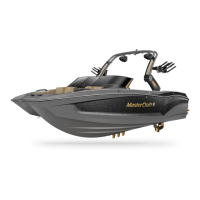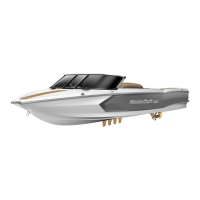Docking and Tie-Up
Approach the dock slowly, with the starboard side of the boat if
possible. The natural tendency to torque steer with the rotation of the
propeller at slow speeds makes docking easier on that side. Also, use
wind and current to your advantage when docking.
Before tying up the boat, be sure to use enough dock bumpers to
protect the boat from damage. If possible, tie-up with the bow toward
the waves. Use good quality double-braided nylon line. Tie-up only to
the lifting or tie-down eyes. Never use the handrails or ski pylon.
If the boat is to be moored for a long period of time, use chang
protectors to protect the gel coat nish. Leave a little slack in the lines,
allowing for some wave movement or tidal action where applicable.
If the boat is to be kept in or near water for the season, consider
the purchase of a boat lift and bottom paint for the hull. These lifts
prevent the build-up of marine growth on the hull as well as protect-
ing the boat from damage typical of on-water storage, such as blister-
ing. Make sure the boat lift supports the hull correctly. See the next
section, Lifting the Boat.
NOTE: On boats that are equipped with the engine syn-
chronizing switch (models with two engines), this switch should
be disengaged during docking or when loading and unloading
the boat from a trailer. These maneuvers require a sensitive
touch and control that may not be realized when the switch is
engaged.
mastercraft 2010 ow n e r ’s m anual • page 11-3

